Bodybuilders spend countless hours in the gym (and kitchen) in hopes of packing on muscle mass and improving their conditioning. However, most people overlook one of the most important aspects of bodybuilding — posing.
Competitive bodybuilding entails much more than building muscle and conditioning. Aesthetics play an important role in the sport of bodybuilding. Besides possessing a spectacular physique, a pro bodybuilder needs to know how to present himself to the judges and audience on stage.
It doesn’t matter if you’re the biggest and most conditioned bodybuilder in the world. If you act like a blob of meat and cannot exhibit yourself on stage, you’ll most probably not get the placing you deserve.
A bodybuilding show generally includes a mandatory posing round and an individual posing routine. Each athlete is expected to be graceful and elegant on stage while being an absolute monster.
There are several bodybuilding poses, more than eight for sure, but a pro bodybuilder can get away by mastering just eight.
The eight bodybuilding poses mentioned in this article are the eight mandatory bodybuilding poses per the IFBB Pro League — the biggest and most popular pro bodybuilding federation. IFBB Pro League is associated with the NPC and organizes the biggest and most prestigious bodybuilding contest, Mr. Olympia.
Level Up Your Fitness: Join our 💪 strong community in Fitness Volt Newsletter. Get daily inspiration, expert-backed workouts, nutrition tips, the latest in strength sports, and the support you need to reach your goals. Subscribe for free!
If you’re a bodybuilding fan, you probably know the contestants are not judged in isolation but compared against each other in posing rounds. There is a separate individual posing round, but as per consensus, callouts and group posing routines are more important.
In this article, we go over the eight poses used to judge the Men’s Open division in the IFBB Pro League. Notably, other divisions in the same federation have different judging criteria and rules.
Must Read: Understanding How Men’s Open Bodybuilding Competitions are Judged and Scored
8 Bodybuilding Poses Every Bodybuilder Should Know About
Each of the eight bodybuilding poses you’ll learn about in this article helps the judges analyze and critique a competitor’s musculature, size, symmetry, and conditioning.
Per the IFBB Pro League, below are the eight mandatory bodybuilding poses that make up the judging and finals round:
- Front double biceps
- Front lat spread
- Side chest
- Back double biceps
- Rear lat spread
- Side triceps
- Abdominals and thighs
- Most muscular
Here is an in-depth look at each of these poses:
1. Front Double Biceps
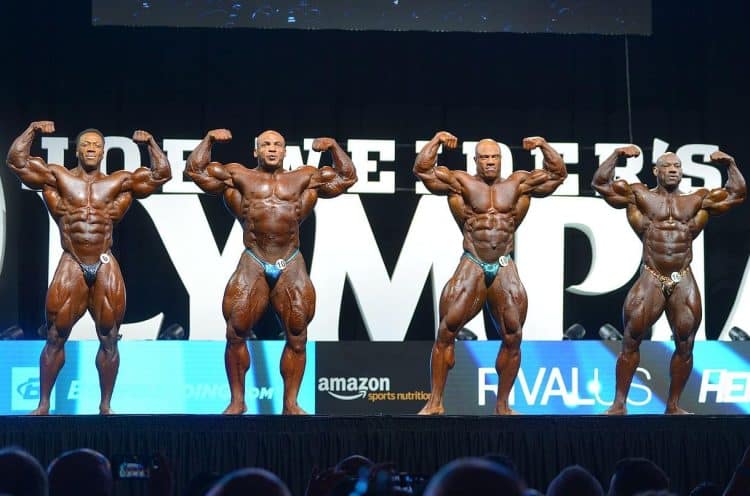
The front double biceps is one of the most popular bodybuilding poses. It is also the pose you generally see people hitting at your gym. The pose showcases your biceps size and peak and conveys forearm size, front lat width, quadriceps size and definition, and front calf musculature.
Here is how to perform this pose correctly:
- Stand with your feet shoulder-width apart.
- Maintain a slight bend in your knees, and flex your legs.
- Suck your stomach in so your ribcage is elevated.
- Raise your arms so your upper arm is parallel to the floor.
- Ball your fists and flex your biceps.
- Pull your elbows in the front slightly to tense your lats and help them flare out.
Although the pose is called the front double biceps, it exposes your lower body; flex your legs as hard as possible to ensure your wheels are displayed in full glory. In all bodybuilding poses where you are facing the judges or facing away, you need to flex all your muscles.
The front double biceps pose is one of the best poses to assess your overall muscle symmetry and check if you have an “X” frame. An X-frame refers to broad shoulders, a tight waist, and sweeping quads.
Check Out: Top 12 Bodybuilders with the Biggest Biceps in the World
2. Front Lat Spread

This pose calls attention to the shoulder and lat-width of a contestant. It also displays chest thickness, front arm and forearm size, quadriceps mass and separation, and calf development from the front.
- Stand with a shoulder-wide stance with your toes pointing out slightly.
- With a slight bend in your knees, flex your quads.
- Close your fingers to form a fist, place them on your sides at the level of your belly button, and hook your thumbs behind your waist.
- Bring your elbows forward to flare your lats.
- Make sure you’re not shrugging your shoulders as it can visibly reduce your back width.
Your upper and lower arms should be at a 90-degree angle while performing this pose. Raise your chest as you bring your elbows to the front. Pull in your abdomen to make your waist look smaller.
3. Side Chest
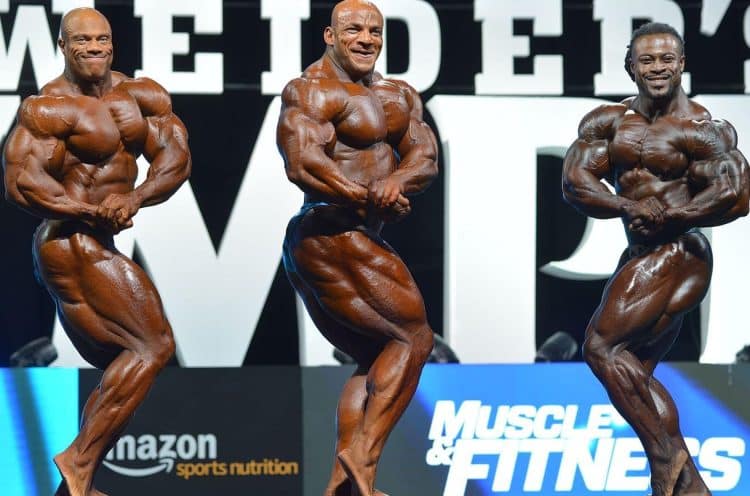
The side chest displays your chest size and thickness from either side. It also exhibits shoulder, arm, and forearm size from the side, along with thigh separation and calf development.
Level Up Your Fitness: Join our 💪 strong community in Fitness Volt Newsletter. Get daily inspiration, expert-backed workouts, nutrition tips, the latest in strength sports, and the support you need to reach your goals. Subscribe for free!
You could choose to hit the pose on either side, depending on the side you feel is more dominant.
- Stand with your dominant shoulder facing the judges.
- Begin by tensing your legs and moving up to your torso.
- Push the ball of your front foot into the floor; raise your heel off the ground to flex your calf.
- Bring both legs together, squeezing your hamstrings and quads to flare your dominant upper leg.
- Grab the wrist of your dominant side with the other hand; draw that left arm up and underneath your ribcage so your lower arm is almost parallel to the floor. Squeeze the life out of your arms.
- Take a deep breath and push your chest out to build as much density as possible.
4. Back Double Biceps
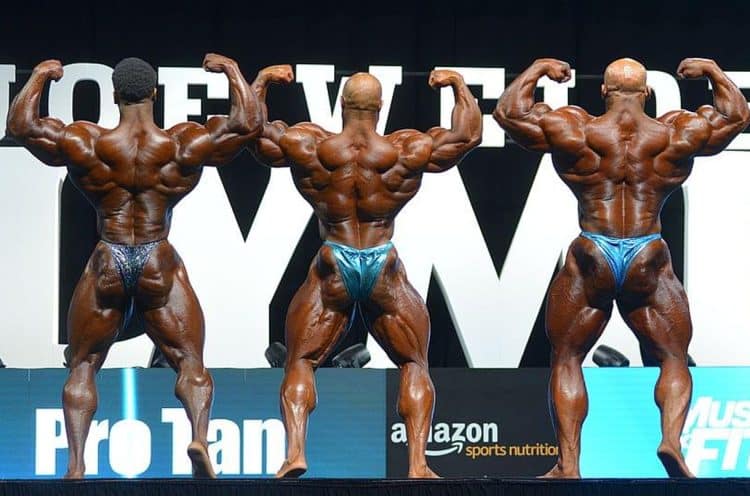
It is often said that bodybuilding shows are won from the back. The back double biceps is one of the poses that can help seal the deal.
This pose shows off your arm size, separation, and peak from the rear. It also displays the thickness and definition of your back muscles, including the trapezius, infraspinatus, teres major, latissimus dorsi, and erector spinae.
Additionally, it puts your glute and hamstrings development and separation, and calf gains up for critique. Here is how to hit the pose:
- Begin in the rear-facing quarter-turn position.
- Place the ball of the foot from your dominant leg back behind the heel of your other foot.
- Bend your knees slightly to tense your hamstrings, calves, and glutes.
- Press the ball of your rear foot into the floor and flex your hamstrings, calves, and glutes.
- Arch your back, bring your arms together overhead, and then draw your elbows down and back as if performing an imaginary lat pull-down.
- At the final position, your upper arms should be parallel to the floor.
- While flexed, rotate your arms slightly backward for a better view of your biceps peaks.
Flare out your elbows while performing the pose, and do not pinch your shoulder blades together as it can take away from your back width. Plus, make sure you’re leaning slightly towards the judges to accentuate your V-taper.
Related: 27 Best Backs in Bodybuilding History
5. Rear Lat Spread
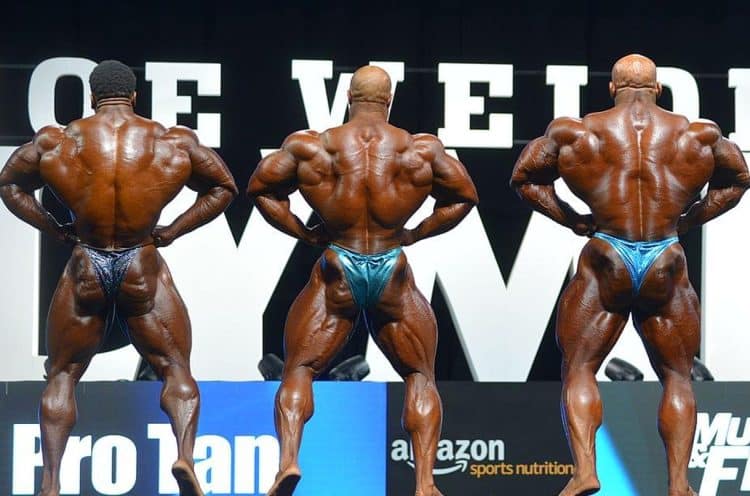
The rear lat spread is primarily used to assess a competitor’s back width. It also shows the thickness of your traps, size of your arms from the rear, glute development and definition, hamstrings size and separation, and rear calf musculature.
- Begin in the rear-facing quarter-turn position.
- Place the ball of the foot from your dominant leg back behind the heel of your other foot.
- Bend your knees slightly to tense your hamstrings, calves, and glutes.
- Press the ball of your rear foot into the floor and flex your hamstrings, calves, and glutes.
- Place your hands on your sides. Alternatively, you could hook your thumbs behind your waist and place your fingers on your waist.
- Pull your elbows forward while rotating your scapulae to flare out your lats.
- Lean back slightly to accentuate your V-taper.
Related: How to Build a V-Taper – Training Guide and Nutrition Tips
6. Side Triceps
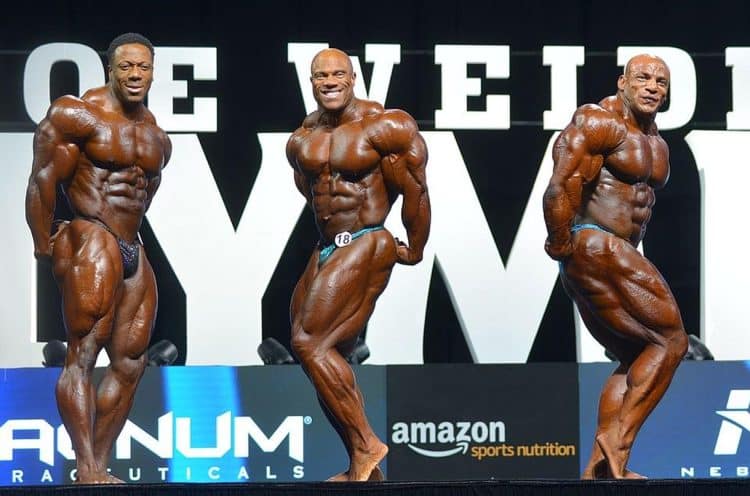
The side triceps pose puts your triceps, especially the lateral head on display. While performing the side chest and triceps poses, rotate your body slightly from one side to the other to give the judges a better view of your size and conditioning.
- Stand with your dominant side facing the audience.
- Press the ball of the feet of the dominant leg into the floor.
- Raise the heel off the floor and flex your calf.
- Flex your legs and then tense up your upper body.
- Bring your rear arm across your lower back, and place your hands behind your back, interlocking the first two fingers of each hand.
- Fully extend your dominant arm to bring out the triceps and flex as hard as possible.
- Keep your abs flexed while performing this pose, and bend forward a little to accentuate your obliques.
The side triceps pose also displays the flow between your shoulder and chest. Round shoulders and a full chest can make you stand out as you hit this pose.
7. Abdominals and Thighs
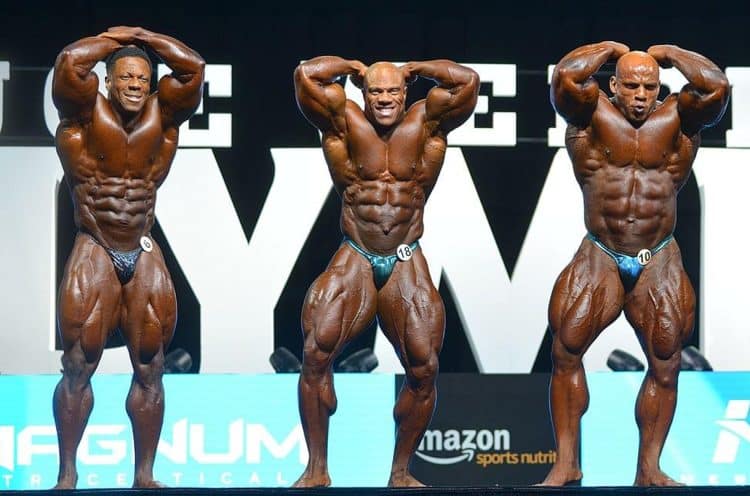
This pose presents your abs, external intercostals, serratus anterior, and quadriceps muscles in full glory. Plus, it puts your pectoral thickness, front arm and forearm size, lat width, and calf size up for critique.
- Place one leg in front of the other and flex your calf and quad.
- Put your hands behind your head, and flex your arms.
- Flare your lats, exhale, and crunch down on your abs.
- Some competitors perform a variation of this pose. They place one hand behind their head and bend at their side to better show off their obliques and intercostal musculature and definition.
Abdominals and thighs are one of the most talked about poses, especially after the introduction of the Classic Physique division. Many experts object to Men’s Open division competitors hitting a vacuum while performing the abdominals and thighs pose as it hides their abdominal definition and structure.
8. Most Muscular
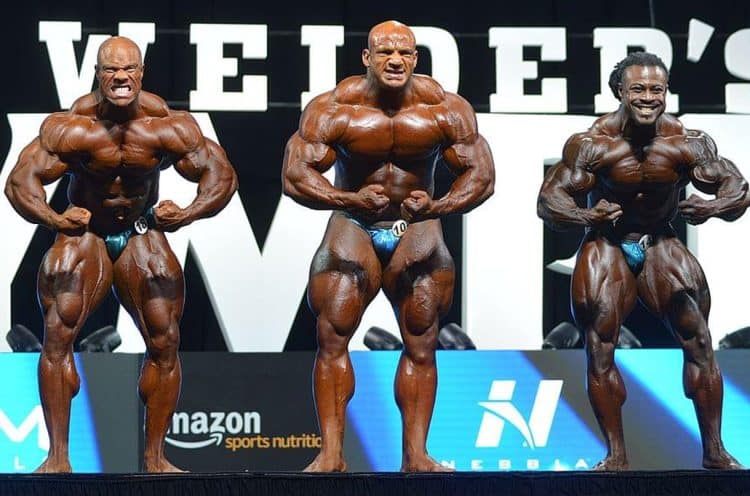
The most muscular, or favorite most muscular, is one of the most popular bodybuilding poses; you hear crowds erupt as soon as this pose is called.
An athlete hits this pose while facing the audience, and it puts his complete body up for critique. There are two main variations of this pose. The first includes a crab pose where a contestant brings his fists together in front of his torso. The other requires placing one hand on your side and bringing the other arm across your abdomen or both hands on your sides and flexing as hard as possible.
Note: While these are the eight mandatory poses, each bodybuilder has the liberty of tweaking them slightly to better display their strengths. However, a competitor cannot modify the overall structure of a pose.
Quarter Turns
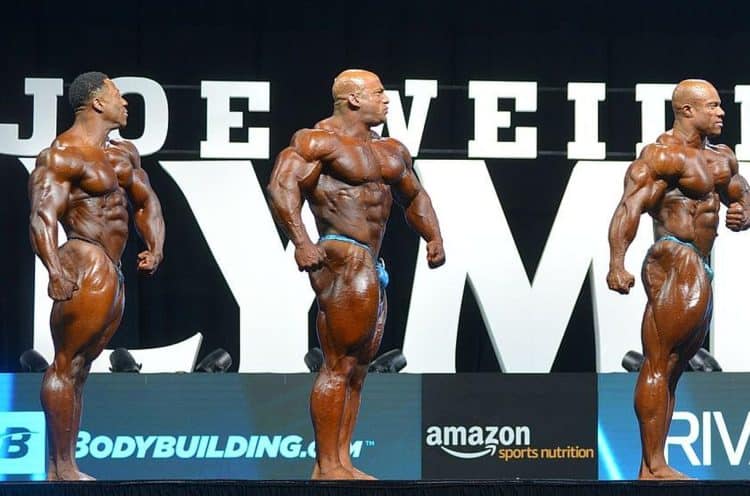
Although quarter turns are not one of the eight mandatory poses, all competitors go through quarter-turning routines in a show. Judges use it to assess each athlete’s muscle size, conditioning, and symmetry from top to bottom.
While performing the quarter turns, ensure you are flexing your audience-facing muscles as hard as possible.
Read also: Understanding the Different Bodybuilding Divisions
Wrapping Up
Most bodybuilders train all year round, never skipping a training session, meal, or supplement intake just for a few seconds on stage. Not practicing and mastering the eight poses can lead you to wait another year to step back on the same stage in hopes of earning the place you deserve.
If you are serious about competing, you cannot overlook the eight mandatory bodybuilding poses. Furthermore, posing can help improve your mind-muscle connection, resulting in better muscle fiber recruitment and pumps.








